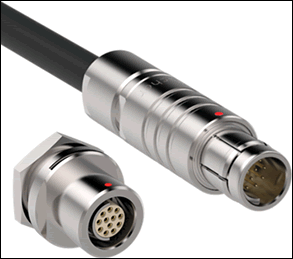How to Specify Nuclear Energy Connectors
Connectors for the nuclear energy industry must be rugged and reliable as they are exposed to extreme chemical, temperature, and radiation conditions. Here are some tips on how to specify nuclear energy connectors.

Fischer Connectors’ stainless steel version of the Fischer Core Series product line.
Nuclear energy demands long-term reliable solutions designed for the most severe environments. Connectors for this industry need to be rugged and reliable as they are exposed to extreme chemical, temperature, and radiation conditions. Choosing the right material and the right sealing level, as well as considering the cleaning and decontamination requirements and mating challenges, are essential when looking for the right solution for any nuclear application.
Materials
Connectors are available in many different materials. For nuclear applications, connectors made of stainless steel are highly recommended. This material, also known as inox steel or just inox (from the French inoxydable) is a steel alloy with a minimum of 10.5% chromium content by mass. In order to secure any necessary resistance, the connector should be made from premium materials 316L, PEEK, and EPDM. Stainless steel is used when both the beneficial properties of steel and corrosion resistance are required, which is the case in nuclear applications.
Sealing
As with all connectors in harsh environments, sealing plays a key role. Look for connectors that are both environmentally and hermetically sealed. This means they are not only protected against fluids but also gases.
To be waterproof, connectors should have an ingress protection rating of IP68 or IP69 (Norm IEC 60529). The IP69 protection is clearly indicated in the IEC 60529 norm. This specifies protection against an envelope caused by intense water jets for a short duration and is typically for high-pressure cleaning, as required for connectors in nuclear environments.
IP68, however, may be defined by each manufacturer individually. A system submerged at two meters for 24 hours affects a connector differently than one at 120 meters for 24 hours, but both situations can be defined as an IP68 rating. Make sure you understand the supplier’s definition of IP68 during your specification process so that your product comparisons are accurate.
Harsh Chemicals
The ability to withstand cleaning procedures, microbiological sterilization, and radioactive decontamination is a necessity for connectors in nuclear applications. Only completely sterilizable connectors (Autoclave, EtO, gamma radiation, Steris, or Sterrad) should be used. The connecting solution should also be compatible with decontamination fluids like decon 90 and RBS 25.
Mating Cycles
These applications require connectors to be frequently mated and unmated, so choose a connector with the durability of 10,000 mating cycles as well as one that is easily mated and unmated. The push-pull locking system is considered the best option, as it is not only extremely safe, but also easy to undertake, even when wearing gloves.
Remote Handling
When using the connectors in hazardous or contaminated environments, remote handling options should also be taken into consideration. The remote handling option enables the user to operate the connecting solution remotely with the assistance of a teleoperator or a robot, ensuring user safety.
Author Arjen Meijer is content writer and project leader for Fischer Connectors.





